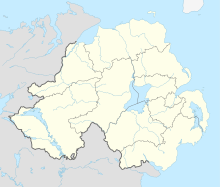
The Avro Shackleton is a British long-range maritime patrol aircraft (MPA) which was used by the Royal Air Force (RAF) and the South African Air Force (SAAF). It was developed by Avro from the Avro Lincoln bomber, which itself had been a development of the famous wartime Avro Lancaster bomber.
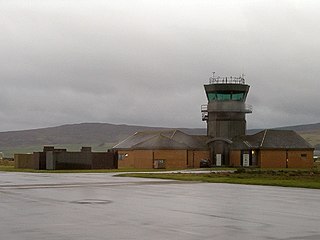
Royal Air Force Machrihanish or RAF Machrihanish is a former Royal Air Force station located near the town of Machrihanish and 3.5 miles (5.6 km) west of Campbeltown, at the tip of the Kintyre peninsula, Argyll and Bute, in Scotland.

Royal Air Force Lossiemouth or more commonly RAF Lossiemouth is a military airfield located on the western edge of the town of Lossiemouth in Moray, north-east Scotland.

Royal Air Force Kinloss or RAF Kinloss is a former Royal Air Force (RAF) station located near the village of Kinloss, on the Moray Firth in the north east of Scotland.
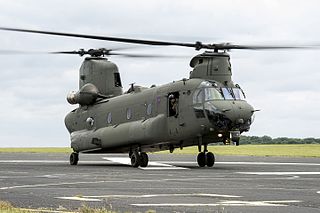
RAF Odiham is a Royal Air Force station situated a little to the south of the village of Odiham in Hampshire, England. It is the home of the Royal Air Force's heavy lift helicopter, the Chinook, and of the King's Helicopter Flight (TKHF). Its current station commander is Group Captain Donal McGurk.
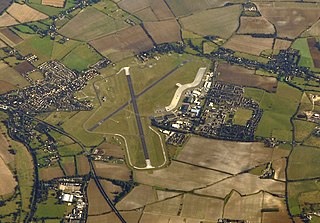
Royal Air Force Benson or RAF Benson is a Royal Air Force (RAF) station located at Benson, near Wallingford, in South Oxfordshire, England. It is a front-line station and home to the RAF's fleet of Westland Puma HC2 support helicopters, used primarily for the transportation of troops & equipment. Flying squadrons comprise No. 33 Squadron & No. 230 Squadron flying the Puma, No. 22 Squadron which provides operational evaluation and training for all aircraft in Joint Helicopter Command and No. 28 Squadron, which is the combined Puma and Boeing Chinook HC6A training unit. Other units include the Oxford University Air Squadron and No. 6 Air Experience Flight, both flying the Grob Tutor T1 light training aircraft used for student and cadet flying training. The National Police Air Service and the Thames Valley Air Ambulance are also based at the station, both operating Airbus H135 helicopters.

Royal Air Force Burtonwood is a former Royal Air Force and United States Army Air Forces base that was located in Burtonwood, 2 miles (3.2 km) Northwest of Warrington in Cheshire, England. The base was opened in 1940 in response to World War II by the RAF and in 1942 it was transferred to the United States of America for war operations.
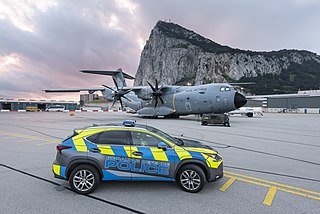
RAF Gibraltar is a Royal Air Force station on Gibraltar. No military aircraft are currently stationed there, but RAF, Commonwealth and aircraft of other NATO nations will periodically arrive for transient stopovers, exercises, or other temporary duty. Administered by British Forces Gibraltar, the station is a joint civil-military facility that also functions as the Rock's civilian airport – Gibraltar Airport, with the civilian airport's passenger terminal building and apron facilities located on the north side of the runway while the apron and hangar of RAF Gibraltar are located on the south side of the runway.
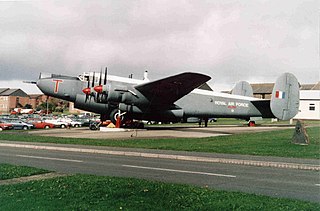
Royal Air Force St Mawgan or more simply RAF St Mawgan is a Royal Air Force station near St Mawgan and Newquay in Cornwall, England. In 2008 the runway part of the site was handed over to Newquay Airport. The remainder of the station continues to operate under the command of the RAF. RAF St Mawgan used to have the widest military runway in the UK (300 ft) and was the home of the Cornwall Air Ambulance service and more recently 505 (Wessex) Squadron Royal Auxiliary Air Force (RAuxAF).

Royal Naval Air Station Yeovilton, commonly referred to as RNAS Yeovilton, is a military airbase of the Royal Navy, sited a few miles north of Yeovil, in the English county of Somerset. It is one of two active Fleet Air Arm bases, the other being RNAS Culdrose). RNAS Yeovilton is currently home to the Royal Navy Wildcat HMA2, along with Army Air Corps Wildcat AH1 helicopters, as well as the Royal Navy's Commando Helicopter Force Merlin HCi3/4/4A and Wildcat AH1 helicopters.
Royal Air Force Nutts Corner or more simply RAF Nutts Corner is a former Royal Air Force station located 2.7 miles (4.3 km) east of Crumlin, County Antrim, Northern Ireland and 9.2 miles (14.8 km) north west of Belfast.

Predannack Airfield is an aerodrome near Mullion on The Lizard peninsula of Cornwall in the United Kingdom. The runways are operated by the Royal Navy and today it is a satellite airfield and relief landing ground for nearby RNAS Culdrose.

Royal Air Force Merryfield or more simply RAF Merryfield is a former Royal Air Force station in the village of Ilton near Ilminster in southwest Somerset, England. The airfield is located approximately 7 miles (11 km) north of Chard, about 130 miles (210 km) southwest of London. It is now RNAS Merryfield and serves as a satellite to the larger RNAS Yeovilton; it is used mainly as a training facility for helicopter pilots.
No. 204 Squadron was a Royal Air Force unit first formed in March 1915 as No.4 Squadron Royal Naval Air Service.
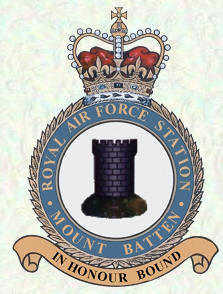
RAF Mount Batten was a Royal Air Force station and flying boat base at Mount Batten, a peninsula in Plymouth Sound, Devon, England. Originally a seaplane station opened in 1917 as a Royal Navy Air Service Station Cattewater it became RAF Cattewater in 1918 and in 1928 was renamed RAF Mount Batten. The base is named after Captain Batten, a Civil War commander who defended this area at the time, with the Mountbatten family motto In Honour Bound taken as the station's motto.
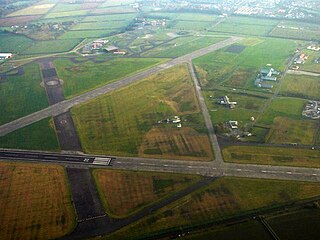
Royal Air Force Ballykelly or more simply RAF Ballykelly is a former Royal Air Force station which opened in 1941 in Ballykelly, County Londonderry. It closed in 1971 when the site was handed over to the British Army as Shackleton Barracks. A small part of the base has been used as a refuelling point by army helicopters and small fixed-wing aircraft usually operating out of Joint Helicopter Command Flying Station Aldergrove near the town of Antrim.

Cawdor Barracks is a British Army installation located 6.3 miles (10.1 km) east of St Davids, Pembrokeshire and 9.8 miles (15.8 km) south west of Fishguard, Pembrokeshire, Wales.

744 Naval Air Squadron is a Naval Air Squadron of the Royal Navy's Fleet Air Arm. It was initially active in 1943, based in Nova Scotia. A second 744 NAS was formed, in early 1944, in Northern Ireland, for Merchant Aircraft Carrier training, meaning the first iteration was re-designated 754 NAS. The squadron's primary focus turned to Anti-submarine warfare training, which then further developed into trialing new submarine detection technology, ending in 1956. In 2018 it reformed as the Mission Systems and Armament Test and Evaluation Squadron.
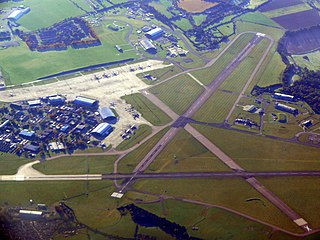
Royal Air Force Lyneham otherwise known as RAF Lyneham was a Royal Air Force station located 6.3 miles (10.1 km) northeast of Chippenham, Wiltshire, and 10.3 miles (16.6 km) southwest of Swindon, Wiltshire, England. The station was the home of all the Lockheed C-130 Hercules transport aircraft of the Royal Air Force (RAF) before they were relocated to RAF Brize Norton.
